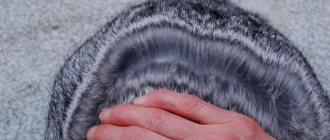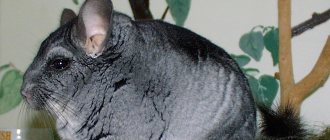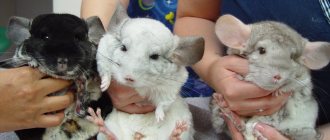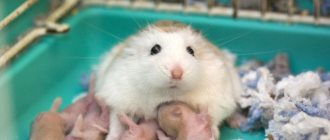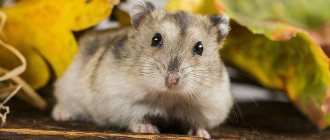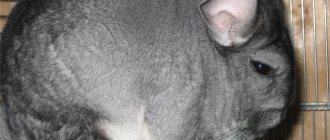- home
- Chinchilla
- Health
03/18/2019 Funny animals with beautiful fur and huge eyes are the object of love for many chinchilla breeders. Their exotic appearance, luxurious fur and long life set chinchillas apart from other rodents. Therefore, owners often decide to breed these amazing creatures.
How to understand that a chinchilla is pregnant
The onset of pregnancy requires breeders to bring the chinchilla pair closer and together. Otherwise, intimacy between the male and female will not happen, and they will be belligerent towards each other.
Experts advise planting females when they reach 12 months of age. Pregnancy ahead of schedule stops the formation of the skeleton and weight gain, which has a bad effect on the development of the female and offspring.
It is difficult to determine pregnancy at the very beginning, since night hours are suitable for mating, and an important moment is easy to miss.
A few hours after mating, the female’s vagina secretes the dried seminal fluid of the male. Evidence is provided by a vaginal plug (a small, white paraffin string) and pieces of fluff on the litter. Those who have recently given birth and first-borns may not have a cork.
The presence of traffic jams for several days indicates successful conception. An accurate sign is the absence of estrus in the female for a month, which is expressed by a change in the color of the genital organs and their swelling.
An accurate method will be x-ray and ultrasound diagnostics. An ultrasound will determine the fact of conception, and an x-ray will determine the number and position of the fetuses.
Pair formation
It is at this age that the reproductive system matures and animals can be distinguished by gender characteristics. In a male, there is a distance of several millimeters between the anus and the penis, but in a female, there is no gap between the vagina and the anus.
Chinchillas are polygamous animals and one male can cover three or four females. When forming pairs, the female is placed next to the male. Let's consider the difficult moment of forming a pair, because in severe cases rodents can seriously injure each other. What do we have to do:
- We place the pair in cages next door for a couple of days;
- Next, we place the animals in a small carrying cage for several hours;
- At this time, we prepare the cage for mutual living, change the filler and carry out general cleaning;
- We launch the first male to prepare and mark the territory;
- And last we launch the female.
This scheme will help avoid conflict situations.
Characteristic signs of pregnancy in chinchillas
In the early stages, it is problematic to understand that a chinchilla is pregnant. Experienced breeders are guided by the following characteristics:
- drowsiness and changes in behavior: decreased activity, kind and peaceful attitude towards the owner. Before childbirth, anxiety, fear of noise and aggression towards the male appear;
- change in color of the nipples at the end of the second month: from white to pink plus slight swelling;
- significant weight gain after the eighth week: 10-15 g weekly. For control, it is recommended to record data on the gain;
- increased appetite due to an increased need for fluids, microelements and proteins;
- frequent urination. Occurs due to pressure from the growing uterus on the bladder;
- abdominal enlargement.
Do they eat berries and nuts?
Chinchillas are incredible gourmets, especially when it comes to nuts and berries. The key problem with these products is that they need to be given in strictly limited quantities. Some berries – no more than once a week. Nuts contain a huge amount of fat, which is harmful to any animal, especially chinchillas.
Particular attention should be paid to the amount of nuts in the diet such as almonds, peanuts, hazelnuts, and walnuts. They should serve as additional food for the animal and provide it with the necessary proteins and fats, but should not form the main diet of the animal. In total this should be no more than 2 nuts per week
In total, this should be no more than 2 nuts per week.
The same applies to the inclusion of berries in the animal’s diet. As a rule, they are used as sweets or when the animal’s body lacks some vitamins. In this case, you can give the animal 1-2 berries per week (rose hips or viburnum). This point does not apply to berries such as cherries and cherries, which have too high an acidity level for chinchillas and can only be consumed in dried form. Famous sweet berries for chinchillas are figs, raspberries, and strawberries.
How long does pregnancy last in chinchillas?
The usual period is 110-115 days. It depends on:
- Number of cubs borne.
- Breed varieties.
- Personal characteristics of a female individual.
When carrying one baby, pregnancy lasts 120 days, several – up to 105 days. Chinchillas are born tiny and have a bare belly. Weight is gained by artificial or natural feeding within a few days.
Information: chinchillas are able to successfully give birth up to 15 years of age. At the same time, the average lifespan is 18 years, with good care - 28 years.
Without harm to health, individuals give up to 2 litters annually. Within a day, the female is again ready to conceive. However, against the background of a new pregnancy and hormonal imbalance, she is capable of killing her offspring. Therefore, the male is separated from her for six months.
How babies are born
Chinchilla offspring are born weighing 30–60 g with open eyes and teeth and can almost immediately move independently over a short distance. Usually after some time they hide under their mother to dry out and warm up.
At first, babies eat mother's milk. Lactation begins one day after birth. Newborns feed on colostrum for 24 hours.
If for some reason they miss him, the owner will have to feed the kids. To do this, prepare a mixture of condensed milk without sugar and chamomile infusion in a 1:2 ratio. It is warmed to room temperature. Feeding is done with a syringe without a needle for the first 7 days every 2 hours, the second 7 - at an interval of 4 hours, the third week - at an interval of 6 hours.
Did you know? The Inca tribes used chinchilla fur and skins to make clothing, and the meat and fat to treat tuberculosis.
At 2 months, small chinchillas will weigh about 80-90 g, at 12 months - 120-130 g. They are ready for independent life from 3 months.
So, if you are planning to breed chinchillas, then you need to prepare for this process, namely: create the required conditions (for example, purchase an additional cage for the male, who will need to be placed during pregnancy and the first time of feeding the babies); find a veterinarian who could provide assistance if necessary; decide whether you can provide the female with high-quality nutrition, care and observation during pregnancy, as well as provide artificial supplementary feeding to the babies, if necessary.
How many children do chinchillas have?
Two weeks before giving birth, the female's genital loop swells and becomes crimson. Pregnancy in chinchillas ends with the birth of 1-3 children. Adults bring up to 4-6 chinchillas. In the latter case, there is a possibility of death of weak cubs, since stronger ones deprive them of food.
A pair of nipples is intended for feeding the cubs, less often - two, although the anatomical structure suggests three pairs. Therefore, the salvation of underfed chinchillas depends on the owner. An artificial formula is suitable for feeding.
Postpartum period
Females who have given birth for the first time often experience postpartum stress. For them, what is happening is not entirely clear. This can be noticed by restless behavior, aggression and rejection of children. Usually the maternal instinct is still stronger and the female accepts the cubs after some time.
Therefore, do not panic if immediately after giving birth the chinchilla refuses to feed the babies.
Just a day after the chinchilla gave birth, she is already ready for another mating. However, this will lead to a lot of stress. Therefore, if the female gave birth in the same cage with the male, he must be placed in another cage for two to three days. After three days, the male can be returned home - he will help the female take care of the cubs.
The diet of a nursing chinchilla is not much different from the diet before and during pregnancy. It is recommended to feed the female with the most pure and vitamin-rich food possible. It’s good to add cottage cheese, milk (powdered) and fresh eggs to your diet. It is recommended to make an additional feeder for nettles, leaves and fruits of rose hips, hawthorn and strawberry leaves, which is placed next to the nest. An additional drinking bowl is also hung next to the nest.
The chinchilla has three pairs of nipples, but not all of them are active. Most often, the first and second pair are dairy. If babies suck nipples, then even in inactive ones milk appears over time. The breeder needs to monitor the feeding of the pups, since sometimes not all puppies have enough milk. Strong cubs often push away weak ones, which leads not only to slower growth and development, but also to death. If some puppies are stunted, they need to be artificially fed.
For feeding, use a mixture of one part unsweetened condensed milk and two parts chamomile infusion.
The mixture is heated in a water bath to room temperature and the babies are given small portions from a syringe without a needle several times a day.
10-14 days after giving birth, the female can return the shelves and all the toys to her cage. The cubs have already grown up enough and do not need constant maternal care - they begin to explore the cage, play, and try adult food.
Chinchilla birth chart
To make it easy to determine the date of birth, there is a simple table of average pregnancy periods. The error in the table is due to the fact that signs of pregnancy are not immediately noticeable, and ranges from one to four days.
The top lines correspond to the mating date (taking into account the error), the bottom lines correspond to the day of birth. For example, if conception occurred on January 6, the chinchillas will be born presumably on April 26. For ease of reference, the required date is highlighted in black or red.
Table of pregnancy and birth in chinchillas:
| January April | 1 2 3 4 5 6 7 8 9 10 11 12 13 14 15 16 17 18 19 20 21 22 23 24 25 26 27 28 29 30 31 21 22 23 24 25 26 27 28 29 30 1 2 3 4 5 6 7 8 9 10 11 12 13 14 15 16 17 8 19 20 21 |
| February May | 1 2 3 4 5 6 7 8 9 10 11 12 13 14 15 16 17 18 19 20 21 22 23 24 25 26 27 28 22 23 24 25 26 27 28 29 30 31 1 2 3 4 5 6 7 8 10 11 12 13 14 15 16 17 18 |
| March June | 1 2 3 4 5 6 7 8 9 10 11 12 13 14 15 16 17 18 19 20 21 22 23 24 25 26 27 28 29 30 31 19 20 21 22 23 24 25 26 27 28 29 30 1 2 3 4 5 6 7 8 9 10 11 12 13 14 15 16 17 18 19 |
| April July | 1 2 3 4 5 6 7 8 9 10 11 12 13 14 15 16 17 18 19 20 21 22 23 24 25 26 27 28 29 30 20 21 22 23 24 25 26 27 28 29 30 31 1 2 3 4 5 6 7 8 9 10 11 12 13 14 15 16 17 18 |
| May August | 1 2 3 4 5 6 7 8 9 10 11 12 13 14 15 16 17 18 19 20 21 22 23 24 25 26 27 28 29 30 31 19 20 21 22 23 24 25 26 27 28 29 30 31 1 2 3 4 5 6 7 8 9 10 11 12 13 14 15 16 17 18 |
| June September | 1 2 3 4 5 6 7 8 9 10 11 12 13 14 15 16 17 18 19 20 21 22 23 24 25 26 27 28 29 30 19 20 21 22 23 24 25 26 27 28 29 30 1 2 3 4 5 6 7 8 9 10 11 12 13 14 15 16 17 18 |
| July October | 1 2 3 4 5 6 7 8 9 10 11 12 13 14 15 16 17 18 19 20 21 22 23 24 25 26 27 28 29 30 31 19 20 21 22 23 24 25 26 27 28 29 30 31 1 2 3 4 5 6 7 8 9 10 11 12 13 14 15 16 17 18 |
| August November | 1 2 3 4 5 6 7 8 9 10 11 12 13 14 15 16 17 18 19 20 21 22 23 24 25 26 27 28 29 30 31 19 20 21 22 23 24 25 26 27 28 29 30 1 2 3 4 5 6 7 8 9 10 11 12 13 14 15 16 17 18 19 |
| September December | 1 2 3 4 5 6 7 8 9 10 11 12 13 14 15 16 17 18 19 20 21 22 23 24 25 26 27 28 29 30 20 21 22 23 24 25 26 27 28 29 30 31 1 2 3 4 5 6 7 8 9 10 11 12 13 14 15 16 17 18 |
| October January | 1 2 3 4 5 6 7 8 9 10 11 12 13 14 15 16 17 18 19 20 21 22 23 24 25 26 27 28 29 30 31 19 20 21 22 23 24 25 26 27 28 29 30 31 1 2 3 4 5 6 7 8 9 10 11 12 13 14 15 16 17 18 |
| November February | 1 2 3 4 5 6 7 8 9 10 11 12 13 14 15 16 17 18 19 20 21 22 23 24 25 26 27 28 29 30 19 20 21 22 23 24 25 26 27 28 1 2 3 4 5 6 7 8 9 10 11 12 13 14 15 16 17 18 19 20 |
| December March | 1 2 3 4 5 6 7 8 9 10 11 12 13 14 15 16 17 18 19 20 21 22 23 24 25 26 27 28 29 30 31 21 22 23 24 25 26 27 28 29 30 31 1 2 3 4 5 6 7 8 9 10 11 12 13 14 15 16 17 18 19 20 |
Is it profitable to breed chinchillas for sale: reviews from owners, diagram
Maxim, Vladivostok, 38 years old
The idea of breeding chinchillas for sale came to us spontaneously. Before this, there was just a couple living with us, and the female was pregnant. We bought the necessary cages for them (at first we lived together), various food and other supplies. Initially, together with the animals, it cost us 25 thousand rubles. The first birth went well - 2 puppies. We also spent on a cage and food. During subsequent births, the female decided to eat her puppies. Next time we watched all night. After about 1.5 years, in the end we already had 3 females with 2-3 litters. It was necessary to install a split system because the livestock had grown and they did not like the heat. We did this in the apartment. But trouble struck again - the cubs began to get sick, and the slightest changes in food led to dulling of the fur. Vitamin supplements corrected the situation a little. But expenses began to rise, and there was no income yet. My wife and I got into debt. In total, we spent more than 600 thousand on their maintenance. We were able to sell all the chinchilla puppies, and then decided to sell the adults as well. But at absolutely not the price we expected. And we earned as much as 156 thousand rubles from them! Draw your own conclusions.
Approximate diagram
Victoria, Ekaterinburg, 31 years old
I have had chinchillas for over 5 years. I breed them not so much for money, I just like these animals. We have a private house - there is a lot of space, my husband made 2 large display cases himself. For the first 3 years, selling puppies did not bring much profit, but we did not strive for this. Then we kept another pair for ourselves, space allowed. But we gave them a whole room. There were complications, but my trusted veterinarian could give advice over the phone and even come at night. The second firstborn gave birth for a very long time. I can’t give exact numbers, but on average we spent about 20 thousand on them. This includes all materials. But, I repeat, we did a lot on our own - significant savings on these same cells. And now, after 5 years, in total we earned a little more than 30 thousand from the sale. Basically, we sold it to maintain the house at an affordable price. Therefore, my conclusion is that you can make money on them if you have a lot of space and this is not your specific goal. Gradually, gaining new knowledge, you can expand your production.
How to care for a pregnant chinchilla
To successfully complete the birth, a pregnant chinchilla needs the following conditions:
- an enclosure free of toys and shelves to avoid injury to newborns. Instead of an enclosure, a low cage with a gap of 10 mm between the bars is suitable (so that the cubs do not end up outside);
- protection from noise and harsh light, plus maintaining silence in the room;
- reduction of walks. It is not recommended to pick up an animal. If necessary, the owner can calm the female by stroking her belly. It is forbidden to lift a chinchilla by the tail, as fright from this can lead to miscarriage;
- placing the male a few weeks before birth;
- X-rays during the prenatal period (contraindicated in shy individuals);
- daily cleaning and flooring made of wood or hay to insulate the floor;
- no swimming three to four days before the event and the next few weeks;
- cleaning the enclosure a couple of days after a successful outcome.
Baby care
The weight of newborn chinchillas varies from 30 to 70 grams and depends on heredity, litter size and the mother's feeding during pregnancy. Premature puppies are born teethed, sighted, covered in fur, and able to move independently. A week after birth, the puppy tried to feed, but continued to eat milk until 1.5-2 months.
Chinchillas tend to lose weight while nursing, so they need very good nutrition. Milk can be included in the diet.
The first 2 weeks are critical for calves. The room temperature should be maintained at around 20°C.
Young chinchillas are weaned at the age of two months, weighing 200-250 grams. Healthy children are energetic, calm, and wag their tails. Weak children have no appetite and are lethargic.
The reason for this may be a lack of milk from the mother. In this case, the young are fed artificially. Unfortunately, there are also situations where puppies become orphans due to the death of the mother or lack of milk (this can be caused by stress or illness), and hungry puppies squeal a lot and become weak. If this happens, then the puppies need to be fed on their own - for this you need to prepare a mixture with a fat content, similar to chinchilla milk.
To do this, it is better to choose dry milk or powdered milk for kittens, which does not contain lactose. You can also feed your chinchillas boiled cow's milk or even the best goat's milk, adding a drop of butter. If your tummy is swollen, a light massage is recommended.
Feed chinchillas from a dropper or syringe without a needle; it is more convenient to use an insulin syringe. The mixture is calculated as follows: 10 ml per 50 grams of child’s weight. So, when feeding every two hours, a chinchilla weighing 50 grams should receive about 0.8-0.9 ml of the mixture at a time. If the formula is appropriate, babies will begin to gain weight and should not have diarrhea or constipation.
During the first week, puppies should be fed every two hours; in the second week, feeding intervals can be increased to three hours. If the puppies are orphaned, they will need extra warmth using a heating element or a hot water bottle.
Should the male be removed from the female after giving birth? Men are different from each other and can be aggressive towards children.
And even the most polite male can accidentally, simply be unlucky, jump, run over or injure a chinchilla. In addition, almost after giving birth, the male may recolor the female, and this is obviously not good for her at all. Allowing a woman to give birth multiple times is undesirable because frequent childbirth exhausts the body.
Of course, the female is capable of giving birth three times a year, but the young may be born weak and unable to live.
What to feed a pregnant chinchilla
Females that bear cubs need high-quality and fresh food.
Products you need to add to the menu:
- chopped plants (alfalfa, calendula and strawberries) plus beebread for good lactation;
- barley or oat sprouts, due to the presence of vitamin E (its deficiency causes fetal malformations or miscarriages);
- pieces of apples 15-20 days before birth;
- special food from a veterinarian store with a high protein content, for better lactation and easy pregnancy.
The diet will be supplemented with greens, a mixture of powdered milk and cereal, and rose hips. Additionally, calcium gluconate is prescribed to support the skeleton.
Thyme and mint have a negative effect on lactation; it is better to exclude them. You will also have to reduce roughage (corn cobs, straw and hay) by about a quarter, increasing the amount of juicy fruits, vegetables and protein (cottage cheese, yogurt, meat and bone meal, etc.).
Possible complications during pregnancy
If the female is healthy at the time of fertilization, theoretically, pregnancy should proceed without complications. Temporary problems may arise if the female does not receive the required nutrition because the owner does not realize that his pet is pregnant. Other possible complications may be related to the quality of care and the environment:
- Miscarriage. Most often it is provoked by problems with the cardiovascular system or the so-called blood conflict. Spontaneous miscarriage can occur at any stage of pregnancy. A special risk group includes females who do not receive adequate nutrition. Severe or prolonged stress can also be a factor that triggers a miscarriage. Injuries, fights, jumping, and falls can lead to spontaneous abortion. If the female has a miscarriage, she eats the premature embryos and placenta. Quite often, traces of blood (stains) are found in the cell.
Signs and preparation for impending birth in a chinchilla
After establishing the breeding day, the chinchilla breeder must:
- Calculate the day of birth using the table.
- Place the male.
- Cover the nest with a dark cloth for a comfortable atmosphere.
- Prepare hydrogen peroxide, a solution of ascorbic acid and glucose, gamavit, ethamsylate, oxytocin, dicinone, calcium gluconate for injection, napkins and diapers, disposable syringes, milk substitute, saline solution and an electric fireplace for heating.
- Change the water daily.
- Agree with the veterinarian about possible obstetric care.
Signs of imminent labor
- Female anxiety. It is aggravated by loud noises and stress, which sometimes leads to early labor and even harm to the newborn.
- The animal uses fluff from its belly and straw a couple of days before the event to build a nest. To prevent the litter from being thrown away, the nest house is placed on the floor with the hole facing up. The owner himself can insulate the nest.
- Inactivity: the animal prefers to lie on its back or side.
- In 2-4 days, the female bends and, as it were, spreads along the floor: this helps the fetus move towards the birth canal.
- A few hours before the babies appear, the stomach drops down, the genital loop turns pink and swells, and the ribs retract.
- Body weight decreases to 25 g, rectal temperature decreases by one to one and a half degrees.
How chinchillas give birth
Chinchillas usually give birth at 5-7 am. Before this, they hardly eat for several days.
False labor in chinchillas occurs within 1-3 days: this is how the body prepares for the birth of babies. The animal stretches, stands on its hind legs, contracts its stomach and draws in its sides, and then rests.
Childbirth takes place without the help of the owner, and lasts several hours. The female rises on her legs and pushes, pushing out the fetus and the baby's place, which she later eats.
Puppies are born sighted and covered with fur. The mother licks them, feeds them and covers them with her body so that they quickly dry and warm up. Her colostrum appears instantly, milk - on days 3-5. Vitamin injections are used to suppress milk flow.
If chinchillas give birth to dead puppies, this causes stress, and you need to quickly get the non-viable offspring out of the cage. If a puppy is born premature, cotton wool soaked in a decoction of chamomile or calendula will help open its eyes. It is used to wipe the muzzle from the nose to the corner of the eyes.
To breed chinchillas, do you need to create the right conditions and choose a pet?
Your first task in order to breed chinchillas is to choose and equip the right room for chinchillas!
Important: The volume of your business directly depends on the area that you are willing to allocate for keeping chinchillas. The minimum cage size for one animal should be 50x50x70 cm (W*D*H). But the larger the cage, the more comfortable the animals feel, the higher their birth rate. Animals should not be allowed to be kept in cramped cages or irregularly shaped cages - round, narrow, multifaceted; this has a negative impact on their psyche, health and reproduction of offspring.
- The house should be dry, bright, and the temperature should be maintained within 20°C. Violation of the temperature regime, dampness and poor lighting adversely affect the health and productivity of animals. Cages in the room should be located in such a way that they are convenient to clean and care for chinchillas.
- It would be a good idea to think in advance about feed and the possibility of purchasing it in bulk. Breeding chinchillas need to be fed high-quality ready-made food with the addition of grains and greens. The same applies to sand. You cannot save on sand by collecting it somewhere in natural conditions; this can result in infectious contamination and the death of all animals.
You can read complete information about the correct choice of house, its arrangement, and the choice of permitted and necessary products in our material “Rules for keeping and feeding chinchillas at home.”
Create the conditions first
Only healthy chinchillas should be bred. And there are some tips on how to determine this.
- Of course, we pay attention to the fur! There should be no pellets. It should be even, moderately fluffy and smooth.
- Stroke the fur against the grain. This needs to be done by examining the skin and the fur itself for the presence of lice, mites, dried particles of pus and other inflammatory lesions.
- the animal’s muscles before purchasing, because it is not visible behind the fur. The rodent should not have protruding chest bones - this can be a signal of illness, as well as excessive exhaustion. Although it could also be poor nutrition. Obesity also needs to be excluded.
- Examine the anus - it should be covered with hair. But it should not be stuck together - this indicates possible diarrhea.
- Pay attention to the eyes - they are expressive, shiny and without purulent or tearful discharge. Yes, sometimes this can be a signal that the animal has dust in its eye. But this could also be a signal of a possible draft or infectious disease (especially if there is discharge from both eyes).
- The chinchilla's nose should also be free of mucus and dry and clean. Sneezing is a signal of a cold or dusty conditions.
- The ears are also clean, with no scabs on the outer or outer ear. Otherwise, this may indicate a tick infestation.
- Breathing is even, without whistling. The chinchilla itself is mobile and active, often does not rub its face with its paws, and does not drag its tail.
You need to purchase chinchillas for breeding from nurseries or farms where breeding work is carried out. It is important that they come from different breeding lines and families with high fertility and are healthy. It is advisable to have a veterinary certificate about the pedigree and health of the animal.
Varieties of color
How to help a chinchilla during childbirth
The process itself does not require intervention. However, difficult births also occur in the following cases:
- Premature sagging;
- incorrect position of the fetus;
- maternal injury;
- two or more births per year.
Attention: labor longer than five hours requires an urgent caesarean section, otherwise the mother will die from heavy bleeding along with her babies.
If the animal gives birth to cubs for longer than 2 hours, it is allowed to drink warm sugar syrup and massage the abdomen from the navel to the pelvis. If the fetus comes out with difficulty, you need to lubricate the body with oil (based on Vaseline) and carefully pull it out, turning it clockwise within seconds of pushing.
Prolonged labor
The problem is typical for primiparous females. You observe that preparations for childbirth have been going on since the morning, for several hours, and now it’s already past noon, but there is no result. The chinchilla is having contractions, she is straining and losing strength. Need help - get a massage. Take the animal on your lap, lift it by the front legs with one hand, and massage the stomach with the other palm, lightly pressing your fingers from top to bottom. Do the procedure for 10 - 15 minutes and put the animal back in the cage. Observe further and repeat the massage if necessary. We are not competent to give advice on injecting any veterinary drugs to “facilitate” or “stimulate” labor. In our practice, things have not yet reached such a degree of necessity. If you realize that you can’t cope on your own, urgently call a veterinarian or rush to the veterinary clinic.
What to feed a chinchilla after giving birth
When chinchilla labor ends with the appearance of babies, it’s time to think about the diet of the new mother.
The basis of nutrition will be calcium and protein. Fruits, nuts, rose hips, sprouted grains and herbs (alfalfa, vetch and nettle) are required.
You can’t do without dry (fat-free) milk, dairy products, meat and bone meal, calcium gluconate, berries and vitamin supplements.
The presence of liquid in the drinking bowl will help the individual cope with thirst. The bath is placed closer to the nest so that the female can easily reach it.
Choosing a cage for keeping a chinchilla
The cage plays a key role in the life of a chinchilla. Before buying a rodent, it is necessary to rationally arrange its housing so that the animal feels comfortable.
Temperature for keeping a chinchilla
Chinchillas are accustomed to a temperate climate, so they do not tolerate sudden temperature changes and extreme heat. For a comfortable stay for an animal, an air conditioner is needed that will maintain a temperature of 18-20 degrees.
Where to place the cage
Since temperature conditions affect the chinchilla’s well-being, the cage should be installed in a cool room.
The cage should not be placed in a draft or in such a way that direct sunlight falls on it. Also check that there are no heating devices or radiators nearby.
Size
Minimum cage size: 50x70x50 cm. A chinchilla cannot be kept in a narrow, cramped cage, otherwise the pet will become obese and die before its fellows.
Strong and durable rod material
The rods must be metal. Chinchillas can easily chew through wooden and plastic materials. The distance between the rods is maximum 2 cm: even a large rodent is able to crawl through a gap of 5-6 cm.
Metal cages
Metal cages work best. Chinchillas are very smart, so make sure that the bolts are strong, it is better to attach small locks on the outside. Otherwise, the pet will get out.
If your budget allows, choose a cage with a removable roof: this will make cleaning your home easier.
Items and accessories for cage equipment
As for cage equipment, you need to purchase the following items:
- A house in which the pet can retire and relax;
- Wooden shelves and stairs are needed to entertain your pet. An inactive lifestyle will provoke health problems: obesity and diseases of the cardiovascular system;
- The drinking bowl and feeder should be hanging so that the chinchilla does not spill the contents or spill liquid while running. It is also better to buy salt and mineral stones mounted, so that it is convenient for the animal to sharpen its teeth;
- Purchase a running wheel, rings and a hanging hammock if the cage size allows.
Chinchillas should have a varied diet
How to Handle Cubs
When the female leaves the nest after giving birth, the owner needs to remove the puppies with disinfected hands and remove the dead ones (if any). Hand washing is only allowed with laundry soap; perfumed soap will leave a smell on the cubs and scare away the female.
Babies left outside the nest need to be dried, warmed, given a drink from a pipette and placed with their mother.
After 24 hours, all newborns need to be weighed: the weight norm is from 30 to 70 g. The procedure is carried out every day at the same hour. Usually puppies gain one gram at a time. If it is less, additional feeding will help, or switching to artificial feeding (if the chinchilla has a small amount of milk).
Children are separated from their mother after 30 days, grouping heterosexual flocks. Young animals are fed with boiled and warm cow's milk for up to six months.
Is it possible to touch newborn chinchillas?
To examine babies after birth, wash your hands thoroughly with laundry soap to avoid infection. Any other agent will leave an odor that the mother perceives as foreign, and there is a risk that she will stop feeding or even bite the babies.
At first, try to handle the babies as little as possible, and don’t forget to wash them. It is best if only the owner does this to avoid odors and the possibility of infection or injury to the tiny animal. When the cubs are a month old, interaction with people will benefit them: in the future they will become social and affectionate.

